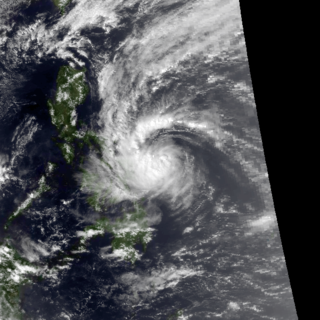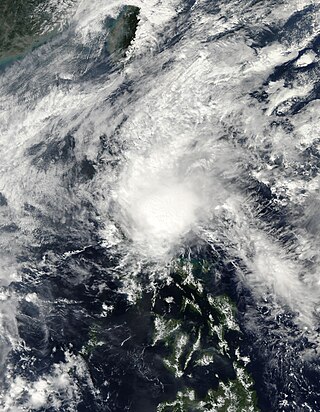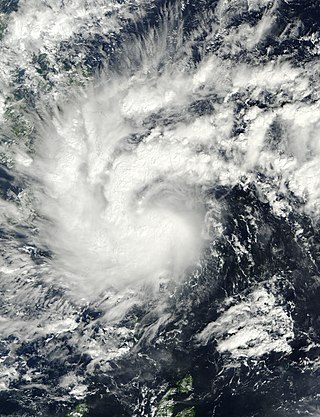
The 2004 Pacific typhoon season was an extremely active season that featured the second-highest ACE ever recorded in a single season, second only to 1997, which featured 29 named storms, nineteen typhoons, and six super typhoons. It was an event in the annual cycle of tropical cyclone formation, in which tropical cyclones form in the western Pacific Ocean. The season ran throughout 2004, though most tropical cyclones typically develop between May and October. The season's first named storm and also the first typhoon, Sudal, developed on April 4, later was reached typhoon status two days later, and became the first super typhoon of the year three days later. The season's last named storm, Noru, dissipated on December 21.

The 2002 Pacific typhoon season was a slightly above average Pacific typhoon season, producing twenty-six named storms, fifteen becoming typhoons, and eight super typhoons. It had one of the highest ACE of any season worldwide, with over 400 units. It was an event in the annual cycle of tropical cyclone formation, in which tropical cyclones form in the western Pacific Ocean. The season ran throughout 2002, though most tropical cyclones typically develop between May and October. The season's first named storm, Tapah, developed on January 11, while the season's last named storm, Pongsona, dissipated on December 11. The season's first typhoon, Mitag, reached typhoon status on March 1, and became the first super typhoon of the year four days later.

Tropical Storm Thelma, known in the Philippines as Tropical Storm Uring, was one of the deadliest tropical cyclones in Philippine history, killing at least 5,081 people. Forming out of a tropical disturbance on November 1, 1991, several hundred kilometers north-northeast of Palau, the depression that would become Thelma tracked generally westward. After turning southwestward in response to a cold front, the system intensified into a tropical storm on November 4 as it approached the Philippines. Hours before moving over the Visayas, Thelma attained its peak intensity with estimated ten-minute sustained winds of 75 km/h (45 mph) and a barometric pressure of 992 mbar. Despite moving over land, the system weakened only slightly, emerging over the South China Sea on November 6 while retaining gale-force winds. Thelma ultimately succumbed to wind shear and degraded to a tropical depression. On November 8, the depression made landfall in Southern Vietnam before dissipating hours later.

Typhoon Ike, known in the Philippines as Typhoon Nitang, was the second deadliest tropical cyclone in the 20th century in the Philippines. Ike originated from an area of disturbed weather southeast of Guam on August 21, 1984, and five days later, developed into a tropical depression. Following an increase in organization, the depression attained tropical storm intensity on August 27. Initially tracking west-southwest, the storm gradually gained strength as wind shear resulted relaxed and Ike became a typhoon on August 30. Continuing to rapidly intensity, Ike turned west and attained peak intensity on September 1, with the Japan Meteorological Agency estimating winds of 170 km/h (105 mph). At around 14:00 UTC that day, Ike made landfall on the northeastern tip of Mindanao. The cyclone emerged into the South China Sea on September 3 as a tropical storm before re-intensifying into a typhoon and moving onshore Hainan. Ike then struck the Chinese mainland as a tropical storm in Guangxi and dissipated on September 6.
Typhoons in the Philippines can occur any time of the year, with the months of June to September being most active, with August being the most active individual month and May the least active. Approximately 20 tropical cyclones enter the Philippine area of responsibility yearly, an area which incorporates parts of the Pacific Ocean, the South China Sea, and the Philippine Archipelago. In each year, ten cyclones are usually expected to be typhoons, with five having the potential to be destructive ones. According to a 2013 Time Magazine article, the Philippines is "the most exposed country in the world to tropical storms". In the Philippine languages, tropical cyclones are generally called bagyo.

Typhoon Durian, known in the Philippines as Typhoon Reming, was a deadly tropical cyclone that wreaked havoc in the Philippines and later crossed the Malay Peninsula in late November 2006, causing massive loss of life when mudflows from the Mayon Volcano buried many villages.

The 1922 Shantou Typhoon was a devastating tropical cyclone that caused thousands of deaths in the Chinese city of Shantou in August 1922. This total makes it one of the deadliest known typhoons in history.

Typhoon Fengshen, known in the Philippines as Typhoon Frank, was the sixth named storm and the fourth typhoon recognized by the Japan Meteorological Agency. The Joint Typhoon Warning Center recognized Fengshen as the seventh tropical depression, the sixth tropical storm, and fifth typhoon of the 2008 Pacific typhoon season.

Typhoon Parma, known in the Philippines as Typhoon Pepeng, was the second typhoon to affect the Philippines within the span of a week during September 2009.

The 2013 Pacific typhoon season was the most active Pacific typhoon season since 2004, and the deadliest since 1975 Pacific typhoon season. It featured one of the most powerful storms in history. It was an above-average season with 31 named storms, 13 typhoons, and five super typhoons. The season's first named storm, Sonamu, developed on January 4 while the season's last named storm, Podul, dissipated on November 15. Most of the first seventeen named storms before mid-September were relatively weak, as only two of them reached typhoon intensity. Total damage amounted to at least $26.41 billion (USD), making it the third costliest Pacific typhoon season on record; behind 2018 Pacific typhoon season and 2019 Pacific typhoon season.

Tropical Storm Merbok, known in the Philippines as Tropical Depression Violeta, was a weak, but destructive tropical storm which worsened the conditions in the Philippines, previously affected by Typhoon Muifa, just 2 days after that storm. This is also the first tropical cyclone recognized by the Japan Meteorological Agency, but not Joint Typhoon Warning Center, since Changmi in 2002. The fortieth tropical cyclone and twenty-ninth named storm of the very active 2004 Pacific typhoon season, the origins of Merbok can be traced from a disturbance in the Philippine Sea early on November 22, with the PAGASA first issuing advisories as Tropical Depression Violeta, to the east of Baler, Aurora. The JMA followed suit, assigning the name Merbok as it strengthened to a tropical storm; however, the PAGASA held the system as a tropical depression. The storm soon made landfall on the night of the same day, while gradually weakening over the high terrains of Luzon. The weakened system emerged off the northwest coast of the country before the last advisory was issued by the two agencies. The remnants moved to the northwest, before dissipating, southwest of Taiwan.

The 1881 Haiphong typhoon was a devastating typhoon that struck Haiphong, in northern Dai Nam, and the northern part of the Captaincy General of the Philippines on October 8, 1881. The typhoon was first detected east of Southern Luzon on September 27, 1881. The typhoon killed about 23,000 people in total.

Severe Tropical Storm Washi, known in the Philippines as Tropical Storm Sendong, was a late-season tropical cyclone that caused around 1,200 to 1,500 deaths and catastrophic damage in the Philippines in late 2011. Washi made landfall over Mindanao, a major region in the Philippines, on December 16. Washi weakened slightly after passing Mindanao, but regained strength in the Sulu Sea, and made landfall again over Palawan on December 17.

Typhoon Bopha, known in the Philippines as Typhoon Pablo, was the strongest tropical cyclone on record to ever affect the Philippine island of Mindanao, making landfall as a Category 5 super typhoon with winds of 175 mph (282 km/h). The twenty-fourth tropical storm, along with being the fourth and final super typhoon of the 2012 Pacific typhoon season, Bopha originated unusually close to the equator, becoming the second-most southerly Category 5 super typhoon, reaching a minimum latitude of 7.4°N on December 3, 2012, as only Typhoon Louise–Marge of 1964 came closer to the equator at this strength, at 7.3°N. After first making landfall in Palau, where it destroyed houses, disrupted communications and caused power outages, flooding and uprooted trees, Bopha made landfall late on December 3 in Mindanao. The storm caused widespread destruction on Mindanao, leaving thousands of people homeless and killing 1,901 people.

Typhoon Haiyan, known in the Philippines as Super Typhoon Yolanda, was one of the most powerful tropical cyclones ever recorded. On making landfall, Haiyan devastated portions of Southeast Asia, particularly the Philippines. It is one of the deadliest Philippine typhoons on record, killing at least 6,300 people in that country alone. In terms of JTWC-estimated 1-minute sustained winds, Haiyan is tied with Meranti in 2016 for being the second strongest landfalling tropical cyclone on record, only behind Goni of 2020. As of January 2014, bodies were still being found. Haiyan was also the most intense tropical cyclone worldwide in 2013.

The effects of the 2013 Pacific typhoon season in the Philippines were considered some of the worst in decades. Throughout the year, a series of typhoons impacted the country, with the worst impacts coming from Typhoon Haiyan, especially in death toll, during November.
From September 20 to 26, 1867, the capital Manila of the Captaincy General of the Philippines experienced the full brunt of a storm, which was believed to be a typhoon. Dubbed as the 1867 Angela typhoon, the capital was submerged in floods from the storm. Many ships either disappeared in waters or were destroyed in the shores near Santa Lucia and Tondo, both towns near Manila Bay. The waves on the said bay were described as "mountainous" by some residents near the coast. The Spanish ship that departed from British Hong Kong named "Malaspina" sank near the Ilocos Region, killing an unknown number of passengers and crew with no survivors. The waters of the Abra River overflowed, killing over 1,800 individuals, mostly due to drowning. This would make the typhoon the fifth deadliest tropical cyclone ever to hit the present-day Philippines. No numerical estimate for the damage caused by the storm is available.
















